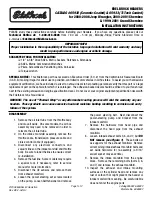
R
fasten the load to the tie-down eyes and
spread the load as evenly as possible.
R
use tie-down eyes and fastening components
which are suitable for the weight and size of
the load.
Load distribution
*
NOTE Risk of damage to the floor cover‐
ing
Excessive point loading on the cargo com‐
partment floor or on the load area can nega‐
tively affect the driving characteristics and
could damage the floor covering.
#
Vehicles with rear-wheel drive: dis‐
tribute the load uniformly. When doing
so, ensure that the overall center of
gravity of the load is always as low and
close to the center as possible and
between the axles near the rear axle.
#
Vehicles with all-wheel drive: distrib‐
ute the load uniformly. When doing so,
ensure that the overall center of gravity
of the load is always as low and close to
the center as possible and between the
axles.
Excessive point loading on the cargo compart‐
ment floor or on the load area can negatively
affect the driving characteristics and could dam‐
age the floor covering.
On Cargo Van and Passenger Van:
R
always transport the load in the cargo com‐
partment.
R
always fasten the load to the rear bench seat
backrests.
R
move large and heavy loads as far towards
the front of the vehicle as possible against
the rear bench seat. Stow loads flush with the
rear bench seat.
R
always additionally secure the load with suita‐
ble load securing aids or tie downs.
R
the load must not protrude above the upper
edge of the seat backrests.
R
transport loads behind seats that are not
occupied.
R
if the rear bench seat is not occupied, insert
the seat belts crosswise into the buckle of the
opposite seat belt.
Securing loads
Notes on load securing
&
WARNING Risk of accident and injury
due to incorrect use of the lashing straps
If you attach the lashing strap incorrectly
when securing loads, the following may occur
in the event of abrupt changes in direction,
braking maneuver or an accident:
R
The tie-down eyes may become detached
or the lashing strap may tear if the per‐
missible load is exceeded.
R
The load cannot be restrained.
This may cause the load to slip, tip over or be
flung about, striking vehicle occupants.
#
Always tension the lashing straps in the
proper manner and only between the
described tie-down eyes.
#
Always use lashing straps designed spe‐
cifically for the loads.
%
Observe the information relating to the maxi‐
mum loading capacity of the individual cargo
tie-down point. If you combine various cargo
tie-down points to secure a load, always take
the maximum loading capacity of the weak‐
est cargo tie-down point into account. During
maximum full-stop braking, forces may act
which can multiply the weight of the load.
Always use several cargo tie-down points to
distribute and spread the load. Spread the
load evenly between the cargo tie-down
points or tie-down eyes.
Always observe the operating instructions or the
lashing strap manufacturer's instructions for the
operation of the lashing strap.
Observe the information relating to the maximum
loading capacity of the cargo tie-down point
(
→
page 246).
As the driver, you are responsible for ensuring the
following:
R
The load is secured against slipping, tipping,
rolling or falling off.
Take usual traffic conditions as well as swerv‐
ing or full brake application and bad roads
into account.
R
The applicable requirements and guidelines
relating to load-securing practices are met.
If this is not the case, this may constitute a
punishable offense, depending on local legis‐
168 Transporting
Summary of Contents for Sprinter 2019
Page 7: ......
Page 19: ...ASpare wheel example 227 At a glance Emergencies and breakdowns 17...
Page 298: ......
















































